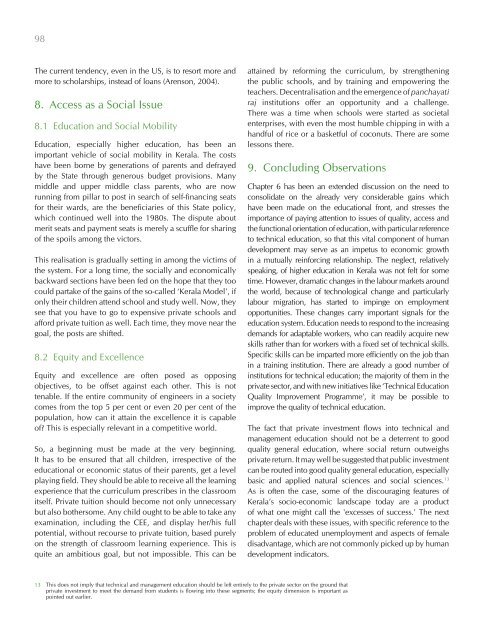Kerala 2005 - of Planning Commission
Kerala 2005 - of Planning Commission
Kerala 2005 - of Planning Commission
Create successful ePaper yourself
Turn your PDF publications into a flip-book with our unique Google optimized e-Paper software.
98<br />
The current tendency, even in the US, is to resort more and<br />
more to scholarships, instead <strong>of</strong> loans (Arenson, 2004).<br />
8. Access as a Social Issue<br />
8.1 Education and Social Mobility<br />
Education, especially higher education, has been an<br />
important vehicle <strong>of</strong> social mobility in <strong>Kerala</strong>. The costs<br />
have been borne by generations <strong>of</strong> parents and defrayed<br />
by the State through generous budget provisions. Many<br />
middle and upper middle class parents, who are now<br />
running from pillar to post in search <strong>of</strong> self-financing seats<br />
for their wards, are the beneficiaries <strong>of</strong> this State policy,<br />
which continued well into the 1980s. The dispute about<br />
merit seats and payment seats is merely a scuffle for sharing<br />
<strong>of</strong> the spoils among the victors.<br />
This realisation is gradually setting in among the victims <strong>of</strong><br />
the system. For a long time, the socially and economically<br />
backward sections have been fed on the hope that they too<br />
could partake <strong>of</strong> the gains <strong>of</strong> the so-called ‘<strong>Kerala</strong> Model’, if<br />
only their children attend school and study well. Now, they<br />
see that you have to go to expensive private schools and<br />
afford private tuition as well. Each time, they move near the<br />
goal, the posts are shifted.<br />
8.2 Equity and Excellence<br />
Equity and excellence are <strong>of</strong>ten posed as opposing<br />
objectives, to be <strong>of</strong>fset against each other. This is not<br />
tenable. If the entire community <strong>of</strong> engineers in a society<br />
comes from the top 5 per cent or even 20 per cent <strong>of</strong> the<br />
population, how can it attain the excellence it is capable<br />
<strong>of</strong>? This is especially relevant in a competitive world.<br />
So, a beginning must be made at the very beginning.<br />
It has to be ensured that all children, irrespective <strong>of</strong> the<br />
educational or economic status <strong>of</strong> their parents, get a level<br />
playing field. They should be able to receive all the learning<br />
experience that the curriculum prescribes in the classroom<br />
itself. Private tuition should become not only unnecessary<br />
but also bothersome. Any child ought to be able to take any<br />
examination, including the CEE, and display her/his full<br />
potential, without recourse to private tuition, based purely<br />
on the strength <strong>of</strong> classroom learning experience. This is<br />
quite an ambitious goal, but not impossible. This can be<br />
attained by reforming the curriculum, by strengthening<br />
the public schools, and by training and empowering the<br />
teachers. Decentralisation and the emergence <strong>of</strong> panchayati<br />
raj institutions <strong>of</strong>fer an opportunity and a challenge.<br />
There was a time when schools were started as societal<br />
enterprises, with even the most humble chipping in with a<br />
handful <strong>of</strong> rice or a basketful <strong>of</strong> coconuts. There are some<br />
lessons there.<br />
9. Concluding Observations<br />
Chapter 6 has been an extended discussion on the need to<br />
consolidate on the already very considerable gains which<br />
have been made on the educational front, and stresses the<br />
importance <strong>of</strong> paying attention to issues <strong>of</strong> quality, access and<br />
the functional orientation <strong>of</strong> education, with particular reference<br />
to technical education, so that this vital component <strong>of</strong> human<br />
development may serve as an impetus to economic growth<br />
in a mutually reinforcing relationship. The neglect, relatively<br />
speaking, <strong>of</strong> higher education in <strong>Kerala</strong> was not felt for some<br />
time. However, dramatic changes in the labour markets around<br />
the world, because <strong>of</strong> technological change and particularly<br />
labour migration, has started to impinge on employment<br />
opportunities. These changes carry important signals for the<br />
education system. Education needs to respond to the increasing<br />
demands for adaptable workers, who can readily acquire new<br />
skills rather than for workers with a fixed set <strong>of</strong> technical skills.<br />
Specific skills can be imparted more efficiently on the job than<br />
in a training institution. There are already a good number <strong>of</strong><br />
institutions for technical education; the majority <strong>of</strong> them in the<br />
private sector, and with new initiatives like ‘Technical Education<br />
Quality Improvement Programme’, it may be possible to<br />
improve the quality <strong>of</strong> technical education.<br />
The fact that private investment flows into technical and<br />
management education should not be a deterrent to good<br />
quality general education, where social return outweighs<br />
private return. It may well be suggested that public investment<br />
can be routed into good quality general education, especially<br />
basic and applied natural sciences and social sciences. 13<br />
As is <strong>of</strong>ten the case, some <strong>of</strong> the discouraging features <strong>of</strong><br />
<strong>Kerala</strong>’s socio-economic landscape today are a product<br />
<strong>of</strong> what one might call the 'excesses <strong>of</strong> success.' The next<br />
chapter deals with these issues, with specific reference to the<br />
problem <strong>of</strong> educated unemployment and aspects <strong>of</strong> female<br />
disadvantage, which are not commonly picked up by human<br />
development indicators.<br />
13 This does not imply that technical and management education should be left entirely to the private sector on the ground that<br />
private investment to meet the demand from students is flowing into these segments; the equity dimension is important as<br />
pointed out earlier.

















